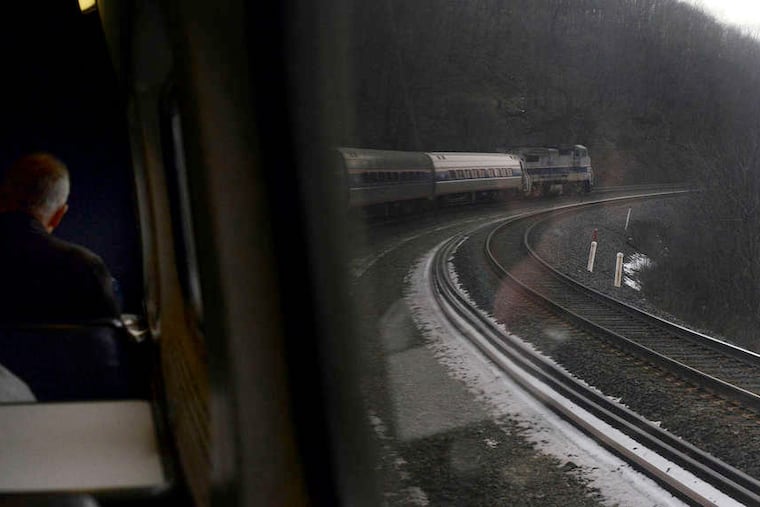The failed Nazi plot to bomb a Pennsylvania railroad
Altoona's Horseshoe Curve was considered one of the eight engineering marvels of the world when completed in 1854.

In a plot fit for an Indiana Jones film, Nazi U-boats once ferried saboteurs to the United States, dropping them off in rubber dinghies along the East Coast under cover of darkness.
Their mission was dubbed “Operation Pastorius” and targets included factories, plants, and rail lines — namely Altoona’s famous “Horseshoe Curve,” a railroad engineering marvel built in 1854 vital to the U.S. shipments of steel, medicine, rations, and even troops.
The saboteurs, who landed in Long Island and Jacksonville, Fla., had also set their sights on Newark’s Penn Station and a cryolite metals plant in Philadelphia.
“I figured they were spies when the first man said he didn’t want to kill me,” a Coast Guardsman who encountered some of the Germans in Long Island testified in 1942.
It’s unclear how close the eight Germans, who had all lived in the United States before, came to destroying Horseshoe Curve, a National Historic Landmark. According to a 2014 Inquirer article, the Nazis named “Operation Pastorius” after Francis Daniel Pastorius, the German-born Quaker lawyer and poet who founded the settlement of Germantown.
Informants
Jared Frederick, a history professor at Penn State Altoona, said the FBI conducted a series of raids in the Blair County town in the summer of 1942, the same day President Franklin Delano Roosevelt issued a military tribunal for the saboteurs.
“Based on the research I’ve done, I’m of the mind that these men had informants and contacts of some nature here,” he said.
According to a 1942 Philadelphia Inquirer article, 100 people were taken into custody during the raids in Altoona and other cities in Pennsylvania and New Jersey for hearings before the “Enemy Alien Boards.” The majority of those rounded up, The Inquirer reported, were Germans.
“There were 200 homes raided here as far as we can gather,” Frederick said. “One of the FBI agents told the New York Times Altoona was part of his investigation because there was a phone call or telegram from Altoona to the New York apartment where the ringleaders were staying.”
One of their main contacts in the U.S., according to the 2014 article, was the Rev. Carl Emil Ludwig Krepper, a Lutheran pastor who served in South Jersey and Philadelphia.
Krepper had allowed “Nazi ideology to pervert his sense of calling,” according to a fellow pastor who wrote “The Nazi Spy Pastor: Carl Krepper and the War in America.”
“My heart is still in Germany,” Krepper allegedly told an undercover FBI agent.
Cold feet and the FBI
Two of the eight saboteurs, according to Frederick, got cold feet and may not have been true believers in Hitler. One of them, George John Dasch, allegedly called the FBI to report the plot.
“They didn’t believe him,” Frederick said.
Six of the eight saboteurs were given the death penalty.
Dasch, according to a 1980 investigation by the Atlanta Journal-Constitution, expected a presidential pardon but went to federal prison instead. He died in Germany and some have suggested his actions were heroic, that turning in his coconspirators saved American lives.
The Horseshoe Curve
Altoona’s Horseshoe Curve, still in use today, was built to get around the towering front of the Allegheny Mountains, which blocked the westward advance of the railroad. The mountains were too dense to tunnel through and too steep to go over. According to Altoona’s Railroaders Museum, engineers used “switchbacks, excavations, and pure innovation” along with Irish immigrant muscle, to build the unique, 220-degree arc.
The curve took three years to build and upon completion, the museum said it was considered one of the “eight engineering marvels of the world.”
“It was known the world over,” Frederick said.
Frederick figures the saboteurs would have utilized dynamite to destroy the rail lines or create massive rockslides from the mountains around it. He doubts either technique would have knocked the horseshoe out for good. While some believed destroying the curve could have tipped World War II to the Axis powers, Frederick thinks it would have mostly damaged America’s psyche.
“It would have delayed troops supplies, medicine, and domestic goods. It really would have thrown a wrench in the works,” he said. “I think the damage was meant to be psychological, though, to create paranoia, and have people looking over their shoulders and question the ability of their government to protect them.”
Visitors to the “Railroad City,” about 235 miles west of Philadelphia, can view the Horseshoe Curve from a visitors center and lookout. There’s also a minor-league baseball team called the “Curve” and some questionable pizza there.
Amtrak’s Pennsylvanian line travels along the Horseshoe Curve once daily, with several stops between New York City and Pittsburgh, including Philadelphia.